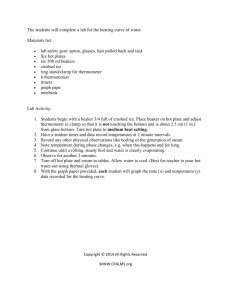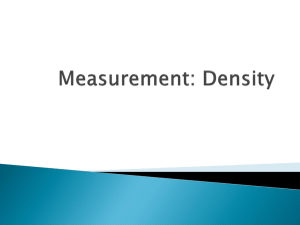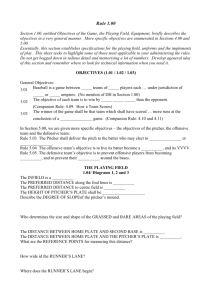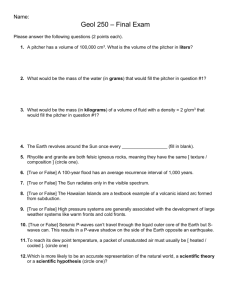The Heat Game - Bibb County Schools
advertisement
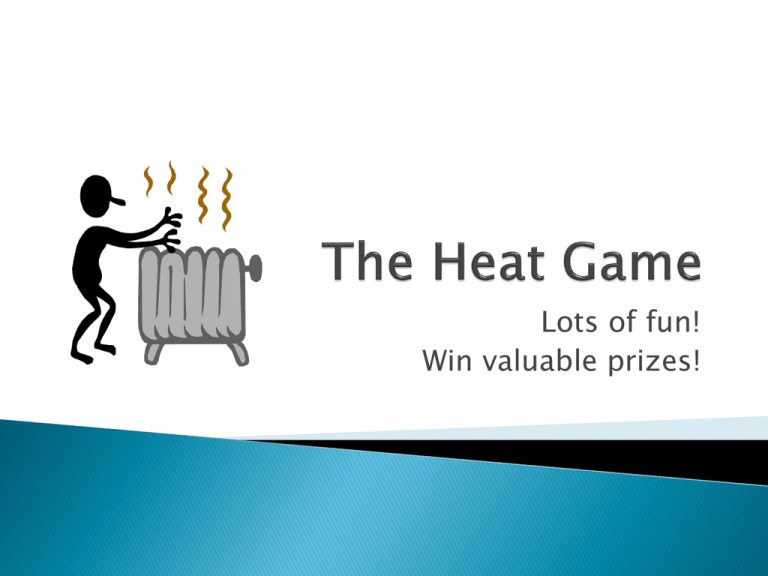
Lots of fun! Win valuable prizes! 1. Plastic foam is a good heat A. conductor. B. absorber. C. insulator. D. emitter. 2. Which temperature scale puts the freezing point of water at 0 degrees? A. B. C. Kelvin Celsius Caloric Fahrenheit Substance Specific heat capacity (cal/g·°C) Water 1.0 Olive oil 0.47 Clay 0.33 Aluminum 0.22 Steel 0.12 Copper 0.092 Silver 0.056 Lead 0.031 3. Using the table above, determine which substance absorbs the most energy in a temperature increase of 1°C. A. Copper B. Lead C. Water D. Aluminum 4. Internal energy is the A. average amount of energy contained in an object. B. total amount of energy contained in an object. C. amount of kinetic energy all the molecules have. D. amount of energy that is transferred from one object to another object. E. all of the above 5. Heat is measured in A. calories. B. kilocalories. C. joules. D. all of the above. E. none of the above. 6. When heat is added to boiling water at constant atmospheric pressure, the temperature of the boiling water A. stays the same. B. increases. C. decreases. Substance Specific heat capacity (cal/g·°C) Water 1.0 Olive oil 0.47 Clay 0.33 Aluminum 0.22 Steel 0.12 Copper 0.092 Silver 0.056 Lead 0.031 7. Two grams of a substance underwent a 1 °C change in temperature when 0.44 calories of heat was added to the substance. What was the substance? (Use information from the table above.) A. Steel B. Water C. Olive oil D. Aluminum 8. The reason an ocean's temperature doesn't vary much from one season to the next is that A. oceans are located in mild regions of the Earth. B. oceans are located next to large land areas. C. water has a low specific heat capacity. D. there are a lot of fish in the oceans. E. water has a high specific heat capacity. 9. Your grandmother places a pitcher of iced tea next to a plate of warm, freshly baked cookies so that the pitcher and the plate are touching. You tell your grandmother that the plates are in thermal contact, which means that A. heat flows from the warm plate to the cold pitcher and from the cold pitcher to the warm plate. B. heat flows from the cold pitcher to the warm plate. C. heat flows within the warm plate but not within the cold pitcher. D. heat flows from the warm plate to the cold pitcher. 10. The metallic coating on the glass surfaces of a Thermos vacuum bottle reduces the amount of energy transferred by A. radiation. B. friction. C. conduction. D. convection. 11. Heat transfer by conduction in metals occurs when A. atoms give off heat in the form of electromagnetic waves. B. large numbers of atoms move from place to place. C. electromagnetic waves travel from one place to another through a vacuum. D. electrons bump into atoms and other electrons. E. none of the above 12. Heat transfer by convection occurs when A. electromagnetic waves travel from one place to another through a vacuum. B. atoms give off heat in the form of electromagnetic waves. C. large numbers of atoms move from place to place. D. electrons bump into other electrons. E. none of the above 13. The reason you can hold your fingers beside a candle flame without getting hurt is that A. B. C. D. E. hot air rises. air is a poor heat conductor. air convects heat well. hot-air convection currents travel upward. all of the above 14. You are feeling sick, so you place a thermometer under your tongue to check your temperature. The directions on the box tell you to leave the thermometer there for three minutes before you read your temperature. Why should you wait? A. It takes some time for the thermometer to raise your body’s internal energy. B. It takes some time for the thermometer to reach its activation energy. C. It takes some time for the thermometer and your body to reach the same temperature D. It takes some time for the thermometer and your body to attain a state of contact. 15. Heat travels from the sun to Earth by A. conduction. B. convection. C. insulation. D. radiation. 16. Specific heat capacity is related to the amount of heat A. transferred by one molecule. B. one molecule contains. C. needed to change the temperature of one gram of a substance one degree. D. a specific object has. E. transferred by one object. 17. Evaporation is a cooling process and condensation is A. neither a warming nor a cooling process. B. a warming process. C. a cooling process also. 18. The molecules in a room-temperature glass of water move around at A. much the same rates of speed. B. no speed (they are not moving). C. a great variety of speeds. 19. If you take a shower in a steamy bathroom and then go to your bedroom to dry off, why will you feel colder in your bedroom? A. Because water evaporates off of your skin, your skin will be warmer. B. Because water condenses on your skin, your skin will be warmer. C. Because water evaporates off of your skin, your skin will be cooled. D. Because water condenses on your skin, your skin will be cooled. 20. Heat is the A. average amount of energy per molecule contained in an object. B. amount of energy all the molecules have. C. total amount of energy contained in an object. D. energy transferred between objects because of a temperature difference. E. all of the above Substance Specific heat capacity (cal/g·°C) Water 1.0 Olive oil 0.47 Clay 0.33 Aluminum 0.22 Steel 0.12 Copper 0.092 Silver 0.056 Lead 0.031 21. How much heat energy is needed to raise the temperature of 1 g of steel by 2 °C? (Use information from the table above.) A. 0.12 calories B. 0.24 calories C. 6 calories D. 0.06 calories 22. As the average kinetic energy of the molecules in a substance increases, the A. B. C. D. temperature of the substance decreases. potential energy of the substance changes. temperature of the substance increases. temperature remains the same.
